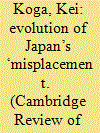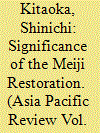|
|
|
Sort Order |
|
|
|
Items / Page
|
|
|
|
|
|
|
| Srl | Item |
| 1 |
ID:
162708


|
|
|
|
|
| Summary/Abstract |
This article explores how memories of the Boshin War (1868) and the Meiji Restoration changed over the course of the pre-World War II period, and how this was reflected in efforts to commemorate those events. It argues that for much of the Meiji period (1868–1912) the trauma experienced by those on the losing side of the Boshin War meant that acts of commemoration remained politically divisive. By the time of the 50th anniversary of the war, in 1917, regional antagonisms had begun to heal and a stronger sense of Japan as a nation united in its devotion to the Emperor led to a significant shift in how the conflicts of the Restoration period were remembered. Ten years later, at the time of the 60th anniversary of the Meiji Restoration, in 1928, the idea of the Restoration as a time of heroic action by patriots on all sides of the political struggles of the time had begun to firmly take root, supported by both government efforts and an emerging mass culture.
|
|
|
|
|
|
|
|
|
|
|
|
|
|
|
|
| 2 |
ID:
177611


|
|
|
|
|
| Summary/Abstract |
This article argues that since the Meiji Restoration, the degree of Japan’s misplacement has changed, depending on its structural power and ability to shape the concept of ‘Asia’ as a region. More specifically, there are three historical turning points: first, from the Meiji Restoration to the Pacific War (hard misplacement); second, post-World War II to the end of the Cold War (soft misplacement); and third, post-Cold War to the present (relative well-placement). In each period, Japan was faced with a different concept of ‘Asia’ and attempted to modify its identity and roles accordingly. The degree of ’misplacement’ is thus not static, but elastic, and such a status is not a permanent attribute of the state. Changes occur when states undertake a role location process, particularly during or after a change in the regional environment.
|
|
|
|
|
|
|
|
|
|
|
|
|
|
|
|
| 3 |
ID:
162706


|
|
|
|
|
| Summary/Abstract |
This article offers a critical appraisal of the Abe Cabinet’s plans to orchestrate a national celebration of the 150th anniversary of Meiji in 2018, following the example of the Meiji Centennial celebrations of 1968. The article begins by introducing some of the criticisms voiced at the time of the 1968 Centennial by prominent Japanese historians such as Tōyama Shigeki and Yamaguchi Keiji, who saw clear links between the post-war celebration of Meiji and broader efforts to revive Japanese nationalism and promote the long-term goal of re-militarization. It goes on to consider some of the public statements that have been made by Prime Minister Abe regarding ‘Meiji 150ʹ and explores the significant gap between the government’s vision of the significance of Meiji and the perspectives that emerge from scholarship on the Restoration period produced in recent decades by historians in both Japan and the English-speaking world. It concludes with a brief consideration of the divide that separated Japan’s post-war historians from some of their American colleagues in the 1960s, and the role that scholars today have to play in combating the manipulation of the past.
|
|
|
|
|
|
|
|
|
|
|
|
|
|
|
|
| 4 |
ID:
162709


|
|
|
|
|
| Summary/Abstract |
Through the story of the Second Kiheitai, a militia formed in the 1860s in the southeastern corner of the Chōshū domain (today’s Yamaguchi Prefecture), this article charts a local perspective on the Meiji Restoration and its commemoration. It explores a series of tumultuous events involving the unit, created in what is today Hikari City in advance of the Tokugawa punitive expedition marshaled against Chōshū in 1866. The article also examines ways in which, influenced by the growing militarism of the age, municipal and national leaders appropriated memories of the unit in the closing days of the Pacific War. During the 1960s, some of the same leaders again commemorated the Second Kiheitai, this time as part of plans for economic expansion in the area. In addition, the article charts some of the ways that the people of Hikari today view the significance of the Second Kiheitai and, by implication, the Meiji Restoration overall, amidst an expansive, prefectural tourism campaign coinciding with the Meiji sesquicentennial.
|
|
|
|
|
|
|
|
|
|
|
|
|
|
|
|
| 5 |
ID:
162710


|
|
|
|
|
| Summary/Abstract |
Marxism, modernization theory, diplomatic history, intellectual history, people’s history, women’s history – from 1950 to the present, historians in Japan and the English-speaking world have taken a variety of approaches to interpreting the causes and events leading up to the Meiji Restoration of 1868. Sometimes they have collaborated; other times they have talked past each other. This article surveys the major trends and offers a few cautionary remarks.
|
|
|
|
|
|
|
|
|
|
|
|
|
|
|
|
| 6 |
ID:
160961


|
|
|
|
|
| Summary/Abstract |
The year 2018 marks the end of the 260-year rule by the Tokugawa Shogunate and the start of a new government headed by the Emperor. The term “Meiji Restoration” is often used narrowly to refer to the political events of 1868, which is why the 150th anniversary is observed this year. More generally, however, the term often refers to the series of changes that occurred after the new government was established, including Japan’s opening to the world, abolition of feudal domains and the samurai class, establishment of the modern Cabinet system in 1885, and proclamation of the Meiji Constitution in 1889 and the opening of the Parliament in 1890. In this article, the author uses the term in this broader sense.
|
|
|
|
|
|
|
|
|
|
|
|
|
|
|
|
|
|
|
|
|